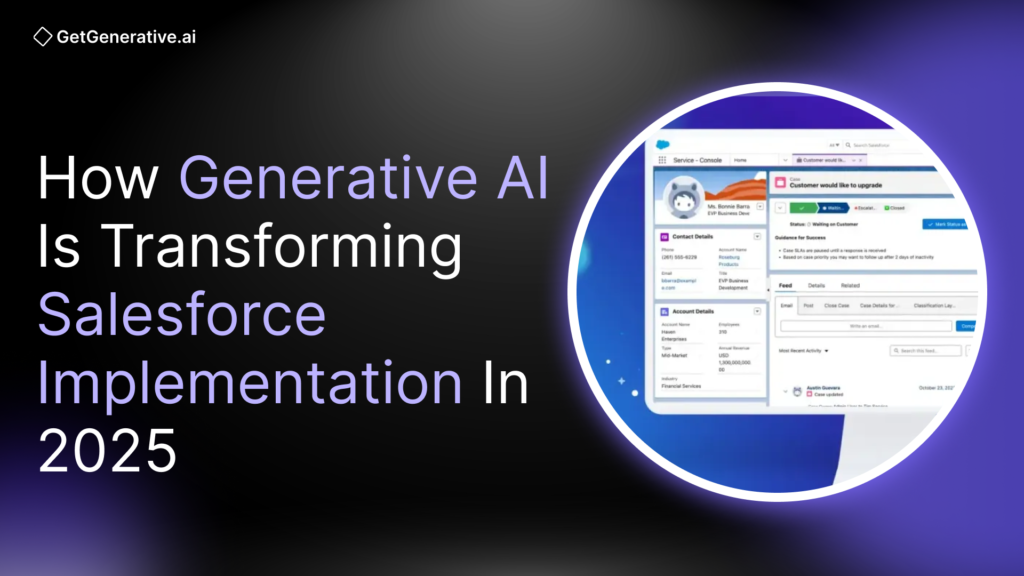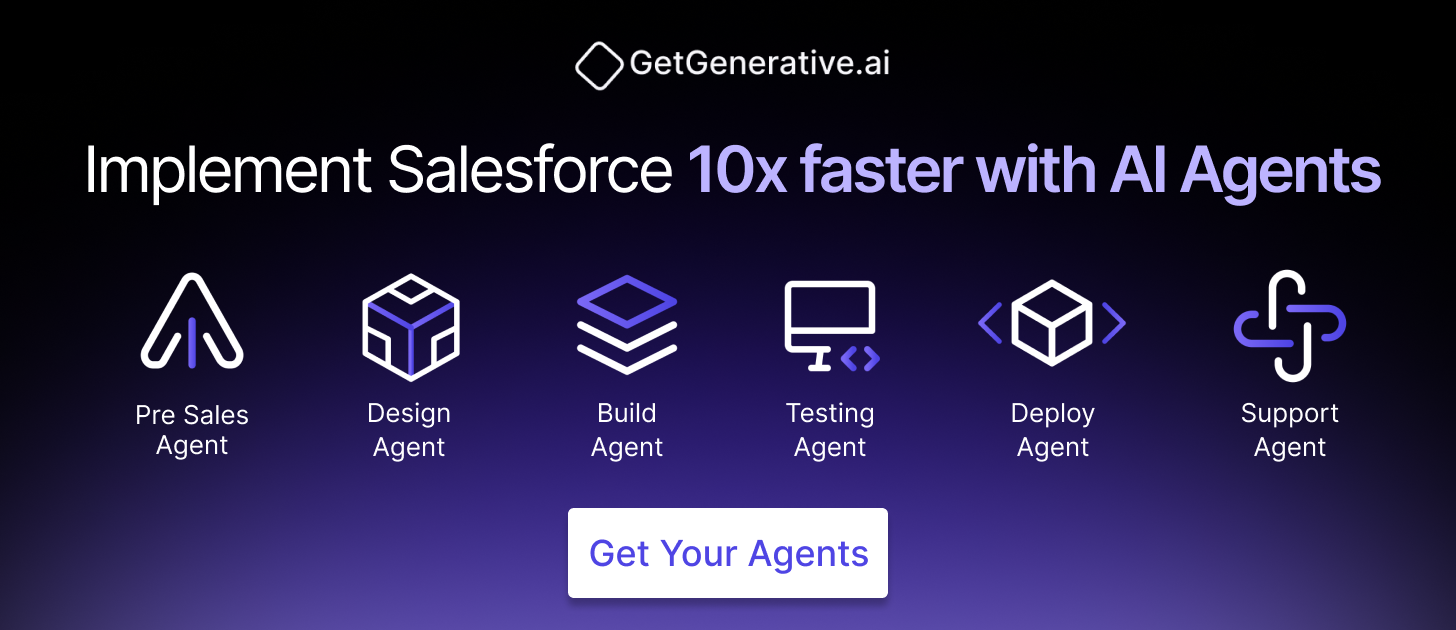How Generative AI Is Transforming Salesforce Implementation in 2025
Salesforce has long served as the digital backbone for many organizations. With its powerful cloud-based CRM capabilities, businesses across industries have optimized operations, increased customer engagement, and unlocked new revenue opportunities. However, a new wave of innovation is changing the way Salesforce projects are delivered and managed. That change is powered by Generative AI.
Far from being just another technology trend, Generative Artificial Intelligence is becoming an integral part of modern Salesforce implementation. This shift is not just about automation. It is about redefining how strategy, design, development, and enablement happen inside the Salesforce ecosystem. Let us explore how this powerful combination of AI and CRM is reshaping the Salesforce consulting landscape.
1. Automating Tedious Configuration Tasks
Salesforce configuration has always been labor-intensive. Consultants and admins spend countless hours creating custom objects, defining validation rules, setting up page layouts, and mapping out flows. These are critical tasks but often repetitive and time-consuming.
Generative AI tools are now capable of interpreting natural language prompts and converting them into ready-to-use Salesforce metadata. For example, if a business user says, “Create a custom object named ‘Customer Feedback’ with fields for rating, comments, and submission date,” an AI-powered assistant can generate the necessary configuration within seconds.
This capability significantly reduces setup time. More importantly, it allows Salesforce professionals to focus their attention on design thinking, strategic alignment, and business impact rather than manual field creation.
2. Accelerating Solution Design and Proposal Generation
In traditional Salesforce consulting, much of the pre-implementation phase is spent gathering requirements, writing proposals, and outlining technical recommendations. This process often involves long discovery meetings, cross-functional documentation, and stakeholder reviews.
With Generative AI, consultants can feed transcripts from discovery calls or upload existing documentation and receive instant output. AI systems can suggest appropriate Salesforce Clouds, recommend integration partners, and even produce visual diagrams of solution architecture.
This not only speeds up the sales cycle but also ensures more accurate scoping, fewer misunderstandings, and faster alignment between business goals and technical execution.
3. Creating Structured User Stories and Test Plans
In agile Salesforce implementation projects, clarity and consistency in user stories and acceptance criteria are essential. Misunderstandings here can lead to delayed sprints, unclear development tasks, or flawed testing.
Generative AI excels in transforming business requirements into structured user stories.
For example: As a sales rep, I want to receive an email alert when a lead’s score exceeds 80 so I can follow up promptly.
From this, the AI can also generate test scenarios, UAT steps, regression test cases, and documentation for quality assurance. This leads to improved sprint velocity and better alignment between business users, developers, and testers.
4. Assisting Developers with Apex, Flows, and Validation Logic
Salesforce developers have long relied on Apex code, Lightning Web Components, and Flow Builder to deliver tailored solutions. In fact, AI already writes 20% of Salesforce’s code, according to recent reports. Now, Generative AI tools trained on Salesforce metadata and best practices are capable of producing code snippets based on functional prompts.
For instance, a developer might enter
“Write an Apex trigger that updates the Account status to ‘Active’ when a related Opportunity is marked Closed Won.”
Within seconds, the AI can generate a basic version of that trigger, including syntax, test classes, and comments.
These AI-generated scripts are not meant to replace developers. Instead, they serve as accelerators, reducing the time required to build and iterate on complex business logic. Review and customization remain essential, but the development process becomes significantly faster and more consistent.
5. Enhancing Data Migration and Integration Planning
Data migration remains one of the most complex parts of any Salesforce implementation. Legacy systems often contain unstructured, inconsistent, or duplicate data that must be cleaned, transformed, and mapped to Salesforce’s data model.
Generative AI helps simplify this process. Using context-aware models, AI can analyze flat files like spreadsheets or SQL exports and recommend field mappings based on naming conventions and data patterns.
For example: “Map column B (Client Name) to Account.Name and column C (Annual Spend) to Account.AnnualRevenue.”
Additionally, when integrating Salesforce with external platforms such as ERPs, marketing automation systems, or eCommerce backends, Generative AI can offer API design suggestions, recommend middleware like MuleSoft or Zapier, and generate sample documentation for integration flows.
6. Improving Change Management and End-User Training
One of the major challenges in any Salesforce rollout is change management. Even the most powerful implementation can fail if users do not understand or adopt the system effectively.
Generative AI is helping to close this gap by offering personalized onboarding experiences. For instance, new users can ask natural language questions like, “How do I create a pipeline report grouped by sales region?” and receive step-by-step guidance, screenshots, or even video walkthroughs in response. AI-driven support systems are already transforming customer service across industries, delivering faster, more contextual responses.
AI-driven chatbots embedded within Salesforce can serve as on-demand support tools, making training continuous and interactive rather than limited to one-time sessions. This improves user satisfaction and ensures better system utilization across departments.
7. Supporting Ongoing Optimization and Post-Go-Live Enhancements
Salesforce implementation does not stop at go-live. Businesses need to evolve their systems based on new goals, user feedback, and system performance.
Generative AI can analyze user engagement metrics, identify underutilized features, and suggest improvements. If a dashboard has low views or filters are rarely used, AI can recommend changes to layout, grouping, or even dataset focus.
Additionally, Salesforce admins can prompt AI to review audit logs, analyze ticket trends, and recommend new automations or process changes. This creates a continuous improvement cycle without overwhelming the internal team.
Real-World Tools Driving AI-Enhanced Salesforce Implementation
Salesforce is not merely integrating generative AI into its platform as an experiment. It has committed to delivering intelligent features across every cloud using a set of purpose-built tools. Let us explore some of the most prominent ones driving this change in 2025.
1. Einstein GPT
Einstein GPT is Salesforce’s generative AI engine, designed to deliver personalized content, responses, and insights across the platform. It can generate emails, chat replies, code suggestions, and sales content using CRM context combined with external AI models.
For Salesforce consultants and admins, Einstein GPT is becoming a key asset during configuration and user enablement. For example:
- In Sales Cloud, Einstein GPT can suggest next best actions and auto-generate opportunity notes based on sales call summaries.
- In Service Cloud, it can summarize support cases, recommend resolutions, and even generate knowledge articles from chat logs.
- In Marketing Cloud, it helps create subject lines, social captions, and dynamic landing page copy based on persona insights.
These capabilities dramatically reduce manual effort and improve alignment between user intent and system output. Want a deeper dive into how it all works? Explore our full breakdown of Salesforce Einstein GPT features and benefits
2. Salesforce Prompt Builder
Prompt Builder is a low-code tool that allows Salesforce professionals to create reusable prompt templates tailored to their workflows. This tool helps design structured, context-rich prompts for Einstein GPT, ensuring consistent and safe generative responses.
Instead of writing ad-hoc prompts, users can define standardized templates like:
- “Generate a follow-up email for a closed won opportunity with a value above $50,000.”
- “Draft a knowledge article based on a support ticket summary and resolution notes.”
Prompt Builder ensures that these AI-generated outputs reflect the company’s tone, branding, and regulatory requirements, reducing the risk of misuse. Want to get the most out of Prompt Builder? Check out our Salesforce Prompt Builder Cheat Sheet
3. Flow GPT and Auto-Flow Recommendations
Salesforce Flow has become the backbone of automation across clouds. With the introduction of Flow GPT, users can describe the desired automation in natural language, and the system can construct the flow structure automatically.
For example, a user could input:
“When a high-value lead is created from a web form, assign it to the regional manager and send a Slack notification.”
Flow GPT can generate the basic flow logic, reducing the need to build each element manually. This accelerates prototyping and improves accessibility for non-technical users.
Salesforce also recommends automation templates based on usage patterns, which helps organizations discover best practices used across similar industries or customer segments.
Limitations, Risks, and the Role of Human Validation
While Generative AI brings speed and scale to Salesforce implementations, it is not infallible. Understanding the limitations is crucial for ensuring responsible usage.
Accuracy and Misinterpretation
AI models may occasionally misunderstand the context or generate incorrect suggestions. For instance, mapping incorrect fields in data migration or producing confusing Apex logic. Always review and test outputs thoroughly.
Compliance and Data Privacy
Some generative outputs may inadvertently expose sensitive data if proper access controls are not configured. Prompt Builder and Einstein Trust Layer are important tools that help enforce role-based data security and prevent confidential information from being used improperly.
Over-Automation
While automation saves time, excessive automation without oversight can reduce the system’s adaptability. Businesses must ensure that human control and exception handling remain part of the solution design.
Salesforce consultants must act as AI stewards, guiding clients on responsible implementation while validating every outcome with domain knowledge and user feedback.
Strategic Guidance for Teams Adopting Generative AI
As you plan to embed Generative AI into your Salesforce implementation approach, keep the following strategies in mind.
1. Start with Low-Risk Use Cases
Begin with non-critical functions like content generation, report suggestions, or email drafting. These use cases offer quick wins without major risk, allowing your team to gain confidence and establish guardrails.
2. Train Users on Prompt Crafting
Prompt engineering is becoming a skill every Salesforce team needs. Run workshops to help users write clear, outcome-focused prompts. Use Prompt Builder to create and share best practices across departments.
3. Establish an AI Governance Model
Create a framework for reviewing prompt templates, validating outputs, and monitoring usage. Assign responsibilities to specific team members to ensure accountability and alignment with business policies.
4. Monitor Metrics and Feedback
Use built-in analytics tools to track user adoption of AI-generated recommendations and outputs. Combine this with user surveys to understand satisfaction and refine your AI strategy over time.
5. Blend AI with Human Creativity
Use AI to reduce repetitive work, not to replace creative thinking or relationship-building. Encourage employees to focus on innovation, strategy, and customer empathy while letting AI handle structured tasks.
Evolving Roles: What This Means for Salesforce Consultants and Architects
The emergence of Generative AI is not eliminating the need for Salesforce professionals. It is, however, changing what success looks like in a consulting or implementation role.
In the past, consultants were often valued for their ability to configure systems, build automation, and customize UIs or data models. While those skills remain useful, clients today are looking for consultants who can architect intelligent systems, evaluate automation opportunities, and advise on ethical AI use.
Salesforce professionals must now adopt a broader set of responsibilities that include:
- Leading AI strategy and prompt development workshops
- Reviewing AI-generated flows, logic, and content for alignment with business objectives
- Collaborating with legal and compliance teams to set up trust layers and usage guardrails
- Helping business users become confident prompt engineers or AI co-pilots
The best consultants in 2025 will be part technologist, part strategist, and part educator. They will guide clients through not just implementation but digital transformation fueled by generative systems.
Changing Delivery Models and Timelines
The integration of AI into the Salesforce implementation process is having a noticeable impact on how projects are scoped, priced, and delivered.
1. Faster Project Kickoffs
What used to take weeks of discovery and documentation can now be generated in days. AI tools can digest transcripts, analyze metadata, and output rough solution architecture, freeing consultants to begin development more quickly.
2. Agile Becomes More Predictive
Although agile methodologies are still relevant, the planning phase now benefits from AI assistance. Tools can anticipate scope creep, suggest story prioritization, and even flag backlog items that are too vague or incomplete.
3. Client Involvement Is More Interactive
With tools like Prompt Builder and Einstein GPT available directly within the Salesforce UI, clients can now experiment with automation, test prompt variations, and give real-time feedback. This turns implementation into a collaborative, continuous learning experience rather than a static delivery cycle.
4. Maintenance Becomes Continuous Optimization
Managed services are evolving into AI-powered enablement programs. Rather than just fixing bugs or updating fields, consultants are offering recurring insight reviews, agent prompt audits, and feature usage tracking as part of their support packages.
As AI continues to take over the mechanical parts of system configuration and documentation, value is shifting toward advisory services, enablement, and innovation guidance.
What Businesses Should Do Now
For business leaders planning a Salesforce rollout or enhancement, here are some immediate actions to take:
Assess Your Readiness
Evaluate your team’s familiarity with AI tools like Einstein GPT or Prompt Builder. Identify gaps in skills and understanding. Even a small amount of internal AI literacy can dramatically improve collaboration during implementation.
Set AI Objectives Early
Define what you want AI to accomplish during and after the Salesforce rollout. Whether it is faster support resolution, smarter lead routing, or better sales content, having these goals defined early will guide your prompt templates, automation flows, and training strategies.
Choose Partners Who Understand AI
Not every Salesforce implementation partner has experience with Generative AI. Look for firms or consultants who showcase actual projects using Einstein Copilot, Flow GPT, or Prompt Builder. Ask to see use cases, prompt templates, and sample outcomes.
Plan for Ongoing Training
AI is not a one-time setup. Make training part of your change management plan. Help your sales, service, and marketing users learn how to interact with AI assistants and personalize their usage over time.
Final Thoughts: Human-Led, AI-Accelerated Implementation
Salesforce implementation in 2025 is no longer just about technical buildouts. It is about orchestrating intelligent, adaptive systems that align with your business strategy and customer expectations.
Generative AI enhances the speed, precision, and personalization of every stage of a Salesforce project. From design and development to adoption and optimization, AI is making it possible to move faster without compromising quality.
Yet, the role of human experts remains central. Consultants, architects, and admins are now facilitators of AI-driven transformation. Their deep business insight, domain knowledge, and empathy are what give AI-generated solutions context and relevance.
That’s where platforms like GetGenerative.ai come in. Our AI-powered agents help you create, refine, and manage discovery questions in minutes, from Pre-Sales to Go-live. You can focus on what matters: strategy, stakeholder alignment, and outcomes. Let AI take care of the rest.
The future of Salesforce implementation belongs to those who can blend technical acumen with creative thinking, process design with automation strategy, and system building with real-time intelligence.
If you are a consultant, the opportunity is massive. If you are a business leader, now is the perfect time to embrace AI-powered CRM as your next competitive advantage.




